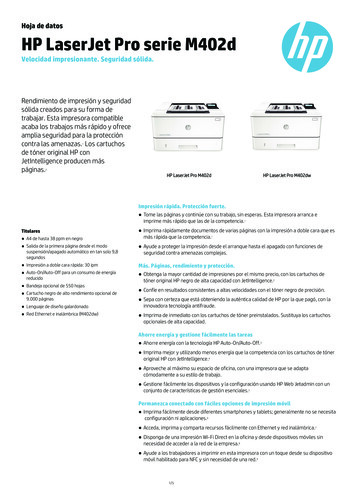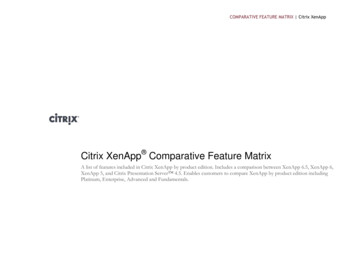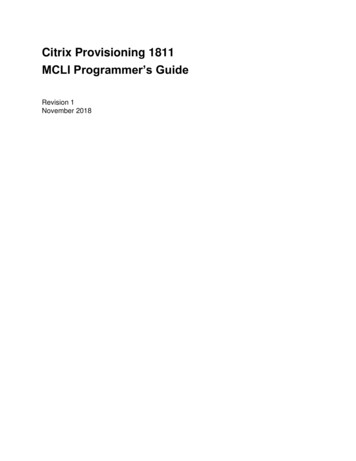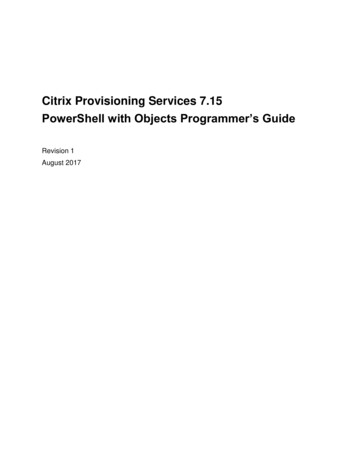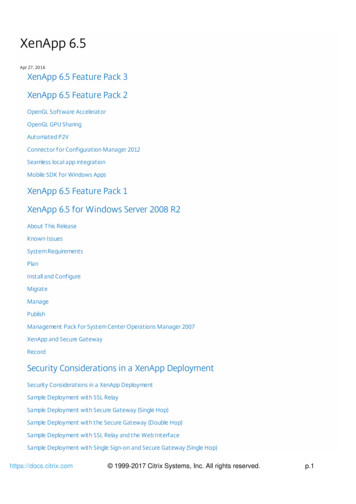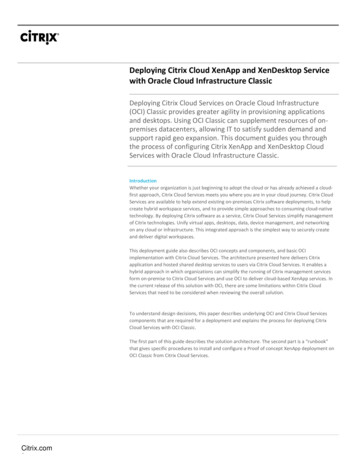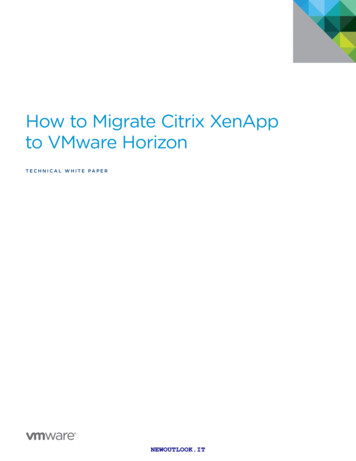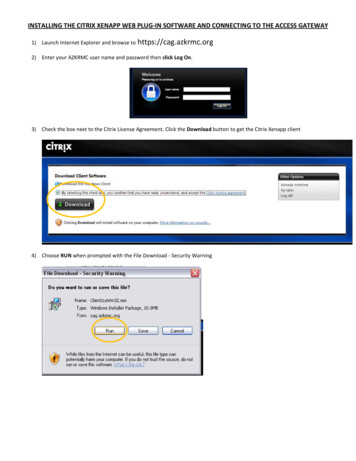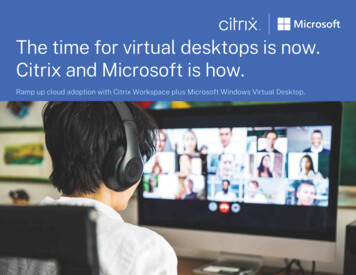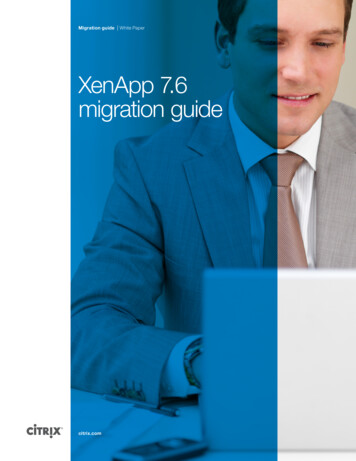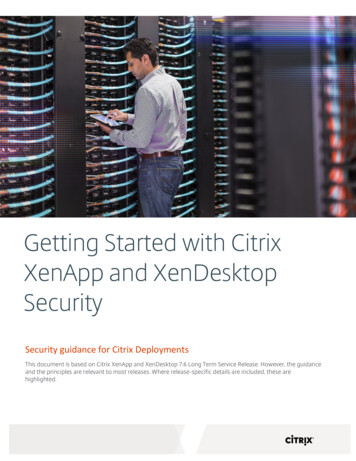
Transcription
Getting Started with CitrixXenApp and XenDesktopSecuritySecurity guidance for Citrix DeploymentsThis document is based on Citrix XenApp and XenDesktop 7.6 Long Term Service Release. However, the guidanceand the principles are relevant to most releases. Where release-specific details are included, these arehighlighted.
Getting Started with Citrix XenApp and XenDesktop SecurityTable of ContentsIntroduction . 3Scope and use cases . 3Audience . 3Security challenges and trends . 4Security considerations in XenApp and XenDesktop deployments . 5Security capabilities and recommendations in XenApp and XenDesktop deployments . 7Identity and access . 7Network security . 10Application security . 11Data security . 12Monitoring and Response . 13Representative deployment . 14Security Standards . 16Common Criteria. 16FIPS 140-2 with XenApp and XenDesktop . 16TSL/SSL . 17IP Security . 18Smart cards . 18Finding more information . 20Compliance and standards . 20Best Practices. 20Products . 21Last updated: 18 March 2016citrix.com
Getting Started with Citrix XenApp and XenDesktop SecurityIntroductionCitrix products offer a wide range of features and capabilities to help secure applications and datawithin Citrix XenApp and XenDesktop deployments. These features and capabilities are particularlyimportant when deploying Citrix XenApp and XenDesktop in government, finance and health sectorenvironments, where security is an essential consideration and often a regulated requirement.This document provides an overview and guidance regarding configuring Citrix environments tomitigate security threats and to comply with security standards.Further documentation is available to support the guidance in this document, providing examples anduse cases. See Finding more information. You can also consult your local Citrix representatives foradvice regarding your deployments and updates.Scope and use casesCitrix offers solutions and associated licensing models for deployments managed and hosted by thecustomer (on the customer’s premises), or deployments managed in the cloud. This document providessecurity guidance for solutions deployed on customer premises, rather than cloud deployments.The primary use case for this document is a deployment that allows local and remote users to accesspublished resources (desktops and applications) managed and hosted on the customer’s premises.This document is based on XenApp and XenDesktop 7.6 Long Term Service Release. However, theguidance and the principles are relevant to most releases. Where release-specific details are included,these are highlighted. For more information regarding the Long Term Service Release, mlAudienceThis document is designed to meet the needs of security specialists, systems integrators andconsultants responsible for designing, deploying and securing Citrix deployments.citrix.com3
Getting Started with Citrix XenApp and XenDesktop SecuritySecurity challenges and trendsIn recent years, there have been many high profile cases of security breaches and attacks. There is nosign of this relenting, endorsing the need to consider security at the design stage, to continuouslymonitor and respond to security threats and to adapt and harden the environment accordingly.It is of course essential to protect sensitive data and intellectual property. Security is becoming morecomplex with the increase in remote working and a highly mobile workforce, including adoption ofbring your own device (BOYD) work styles. The result is more unmanaged and/or unknown devicesaccessing resources.Security complexity increases with the emergence and use of more types of devices (including mobiledevices, tablets and internet-enabled devices) and additional network types (such as 3G/4G, Wi-Fi andBluetooth).Monitoring, identifying and responding to security breaches is a significant challenge and essential toensure business continuity and security of resources.Additionally, many sectors insist on certain accreditation or security compliance. For example, to deployCitrix products within US Federal environments, the deployment must be FIPS compliant.Citrix products offer substantial security features and options to help safeguard sensitive data andintellectual property, ensure business continuity, and help organizations comply with securitystandards. This document provides guidance and recommendations to help you design and manageyour Citrix deployment.The Citrix Ready Marketplace includes an extensive list of verified products, trusted solutions, andenterprise-enabled apps. See www.citrix.com/readycitrix.com4
Getting Started with Citrix XenApp and XenDesktop SecuritySecurity considerations in XenApp and XenDesktop deploymentsThere are various security considerations when designing and deploying Citrix XenApp andXenDesktop. This diagram shows key security areas and deployment options that help assureconfidentiality, integrity and availability of resources.To ensure security, integrity and business continuity, you need to determine your IT governance, riskmanagement and compliance strategy. Your strategy should include security risk assessments,procedures, process, training and awareness.The integrity and confidentiality of data is essential. Appropriate encryption, segmentation of users andaccess to resources, and managing the location of data, helps provide compliance that is moreconsistent, enforceable and verified.You can protect against data loss outside the corporate network by restricting data access and transferto user devices. For example, employees travelling on business may lose their laptop (in a taxi forexample), or have a device seized by border control, and you can restrict and protect the data on thesedevices.You can implement privacy controls and configuration, to benefit both the organization and users.The key areas, shown in the diagram, help you optimize your deployment and mitigate security risksand achieve your security and compliance strategy:Identity and AccessWell-designed identity management and access control determines who can access resources, howthey authenticate and, once authenticated, the resources available and the level of access granted.Identity and access are an important consideration for all types of accounts including users,administrators and service accounts.Benefits of a sound identify and access strategy include secure and controlled access to resources frompersonal devices (for example, employees working remotely and employees bringing their own devicesto the office) and non-employees (for example, contractors, partners, suppliers and students).Authentication within large scale deployments is simplified, with a common URL provided to log onand access the required and relevant resources.citrix.com5
Getting Started with Citrix XenApp and XenDesktop SecurityNetwork SecurityAppropriate network security is required to ensure network traffic is secured and encrypted throughoutthe deployment, from user devices through to servers hosting resources and data. The type and level ofnetwork security required may also need to meet specific standards. For example, you may need toensure end-to-end TLS encryption and specific network Access Control Lists (ACLs).For examples of end-to-end TLS and FIPS compliant XenDesktop and XenApp deployments (includingNetScaler), see Citrix XenApp and XenDesktop 7.6 FIPS 140-2 Sample Deployments.Application SecurityApplication provisioning, hosting and monitoring must be designed to ensure applications are availableto appropriate users only and hosted across servers, as needed, to minimize security risks.Contextual application security can be enabled using application policies to ensure that applicationsonly have access to what is needed in a specific situation. You can host applications in appropriate silosand use third party tools to prevent cross application security breaches.Data SecurityProtecting data is paramount and a feature of Citrix XenApp and XenDesktop, where data is protectedin the data center. Data security can be strengthened through the configuration of Citrix virtualchannels, Windows policies and third party tools.Data security policies ensure sensitive data is kept in the data center (and off user devices), restrictingaccess to resources and sensitive data on a contextual per-application basis. For example, policies mayonly allow certain users and devices access to sensitive data and applications such as payroll data. Youcan enable and configure endpoint validation and control to ensure policy-verified access, residual datamanagement, and restrict and define the level of access to user device drives and peripherals.For examples of policy configuration to restrict access to user device drives and peripherals, see therelevant procedures in the Common Criteria Evaluated Configuration Guide for XenApp andXenDesktop 7.6, available from ance/commoncriteria.htmlMonitoring and ResponseMonitoring is central to your security risk and ongoing assessment strategy. Monitoring allows you todetermine application usage, compliance, optimization and security. Based on monitoring logs, eventsand alerts, you can proactively identify and respond to security risks.Monitoring for security related issues, enables you to check the status of your deployment and identifyirregular events or issues. You can respond as needed to address issues, refine configuration, andsupport users.citrix.com6
Getting Started with Citrix XenApp and XenDesktop SecuritySecurity capabilities and recommendations in XenApp andXenDesktop deploymentsCitrix products offer many security features that can be configured to suit your environment,requirements, risk assessment and compliance. You need to review your security requirements andconfigure the products and features appropriately.Security should be a key consideration during the planning phase. Configuring, testing and refiningyour deployment in a staging environment, ahead of rolling out a production deployment, is highlyrecommended.To ensure ongoing mitigation against security threats, continuous monitoring, auditing andassessment of your deployment is also essential.Citrix recommends the following security design and implementation options to help address securitychallenges and threats.Identity and accessTo determine identity and access needs, consider and confirm the requirements for each type ofaccount, defining the identity, authentication and access rights and privileges. Each account typepresents different challenges and requires specific identity and access configuration.Account typeIdentityAccessUserAuthentication, as defined byadministrator. The authenticationrequired is tailored to yourenvironment (for example, twofactor authentication may berequired).Based on their privileges, users are ableto access appropriate publishedresources.AdministratorAuthentication to provide access tomanagement tools and consoles.Administrators have direct access tomanagement tools and consoles,usually from within the network, withaccess to security sensitive resourcesand data. Administrators requireelevated privileges.Service AccountAutonomous service account used byspecific program/process. Programspecific authentication.Specific privileges to access programs,resources, and scripts.citrix.com7
Getting Started with Citrix XenApp and XenDesktop SecurityIdentity and authenticationYou need to determine how users must authenticate to access resources and review the requiredauthentication policies.When considering identity and authentication in a secure environment, multi-factor authentication isrecommended. For example, a combination of user name, password, plus additional methods such ashardware or software-based token access. Multi-factor authentication is likely to be mandatory forremote access. Depending on your security requirements and policies, multi-factor authenticationcould be extended to within the corporate environment and network.Smart card authentication is mandatory within certain environments. For example, in the USDepartment of Defense, smart card access is used to authenticate all users, local and remote. Smartcard access is supported and can be configured in a XenApp and XenDesktop deployment. For moredetail, see Smart Card Support.StoreFront and, optionally, NetScaler are deployed and configured to manage access to publishedresources and data. For remote access, NetScaler is recommended. For internal access, StoreFront isoften appropriate. However, the exact configuration depends on your security risks and needs.To avoid security breaches, ensure appropriate password policies are in place. For example, thepassword policy may require passwords to comprise at least eight characters and include at least oneupper case letter and one number or symbol. The password expiration period must also be defined.Other rules such as whether or not previous passwords can be reused may be defined. It is important tohave a password policy in place and to ensure it is applied to all accounts (users, administrators andservice accounts).Access and privilegesLeast privilegeFor all account types (users, administrators and service accounts), you should grant the minimumprivileges needed to allow completion of tasks. This is often referred to as the principle of leastprivilege.Some organizations achieve this through granting elevated privileges to confirm everything works,then reset to minimum privileges and gradually increase privileges until the account has adequateprivileges to perform the required tasks.User privileges - publishingFor publishing purposes, use Active Directory groups and policies. Configure the required privileges forthe relevant AD group and add the appropriate users to the group. Avoid publishing to all users(Domain Users), individual user accounts, anonymous (non-authenticated) users or shared accounts.citrix.com8
Getting Started with Citrix XenApp and XenDesktop SecurityAdministrator privilegesAccounts for administrators and support staff require elevated privileges. As with other account types,use groups (AD groups, for example) to provide access. The group must: Include the relevant users (administrators or support personnel)Be configured to allow access to the required consoles onlyBe based on role (access and privileges needed to complete tasks)Be configured to allow the level of logging required by governance and regulatory complianceRegularly review reports to determine whether users can be removed from the group. This isparticularly important with administrator accounts; roles and responsibilities are likely to changeregularly and therefore group membership and management rights may need to be modifiedaccordingly.Ensure you have at least two users allocated to each group so there is no risk of only one personavailable to complete tasks (as that could result in a single point of failure).Do not use default names and passwords for administrator accounts and, as with other accounts,ensure an appropriate password policy (and strong authentication) is in place.Your deployment will include various administrator accounts, across various systems. For example,administrators for management of XenApp and XenDesktop, administrators to manage your datastorage, administrators to manage your database infrastructure. Ensure you monitor and track alladministrator accounts as they are all likely to have elevated privileges and data access.Note that NetScaler, XenApp and XenDesktop (and other third party tools) include default delegatedadministrator roles. This may be a consideration when configuring AD groups for administratorpurposes and roles. Consult the relevant product guides for more information on default roles.Service account privilegesWith elevated privileges and often poor password management (for example, password never expires),and in some cases access to multiple components, service accounts can be a target for security attacks.Avoid using a single service account for multiple components or programs (avoid aggregated ‘superaccounts’).As with all accounts, ensure proper password policies are in place. Where a service account is a localcomputer account (rather than a domain account), it is necessary to manually update the passwordregularly.Access RightsYou can configure SmartAccess, a feature of XenApp and XenDesktop, to help secure your deployment.SmartAccess allows you to control access to published applications and desktops based on NetScalerGateway session policies. You configure pre-authentication and post-authentication conditions thatmust be validated to access published resources. These conditions can cover security relatedrequirements such as checks for the correct version of virus protection software and domainmembership. You can also configure conditions, based on XenApp or XenDesktop policies and/orNetScaler SmartControl, to control access to local devices and processes (for example, user device drivemapping, clipboard, and printer mapping). Additionally, specific privileges in XenApp, includingclipboard usage, can also be configured on a per-application basis.citrix.com9
Getting Started with Citrix XenApp and XenDesktop SecurityNetwork securityCitrix products provide many security features to help secure the network. Each network compriseslayers (referred to as enclaves within government environments), as shown in this example:In the example, users in the Sales group log on and access the Sales application (salesforce) and thesalesforce data. Users in the Human Resources team access the HR application and data (provided bySAP). The diagram shows the location of components and resources within the network layers.The network layers are described below:LayerExternalThis includes devices and networks that are not controlled by the organization. Thisis of course the least trusted layer. In many cases, users and partners will access yournetwork from here.PresentationThis outermost layer managed by you (the external layer is not controlled by you), isthe most likely to be attacked. It includes NetScaler, within a DMZ, and access tovirtual applications and desktops.ApplicationThis layer contains your application servers and management consoles.DataThe inner most layer and the most protected layer. It contains your data andintellectual property – hosted on your database and file server infrastructurecitrix.com10
Getting Started with Citrix XenApp and XenDesktop SecurityA well designed network, with secured and discrete layers, helps prevent security breaches. Each layer isprotected and isolated; network traffic can move between adjacent layers only (traffic is unable to skiplayers).Firewalls are used to protect and control communication between the layers. Only essential ports areopened, restricting traffic to certain ports and protocols. Network traffic is encrypted, throughout thedeployment and all layers. For an example of network encryption and firewall configuration, see theRepresentative deployment . In addition to firewall protection within the network, ensure appropriatefirewalls are configured on user devices.Data is kept secure and isolated. Management is conducted within the secure inner application layer tosafeguard sensitive configuration and data.Application securityWithin a Citrix deployment, there are various techniques you can employ to protect the applicationlayer. The biggest security threat is application jailbreaking (also known as application breakout), wherepotential malicious activity can occur after gaining access to the underlying network infrastructure.Third party tools, such as Microsoft Windows AppLocker, help improve application security byrestricting who can run applications and also the type of applications that can be run. Using AppLocker,you specify which users and groups have access to particular applications. You create rules for yourorganization, to allow or deny access to specific applications. AppLocker also allows you to restrict andprevent access to different types of files, including executable files and scripts.You can configure separate and discrete application servers and files servers, within your XenApp andXenDesktop environment, to keep applications and data protected. For example, host payrollapplications and data on separate dedicated servers and restrict access to the payroll applications (forexample, only users in ‘Human Resources’ group are able to access the payroll applications). With theapplications and data managed on separate file servers and databases, they are protected should therebe a jailbreak elsewhere in the deployment.As with data security, publish applications to specific groups of users only. Avoid publishing toindividual users, anonymous users or shared accounts. Also, if appropriate, you can enforce higherlevels of credential access for more sensitive applications. For example, payroll applications may requirea higher level of authentication such as multi-factor authentication.Where a number of applications are hosted on the same server, you can isolate and restrict access toapplications using NTFS (New Technology File System) permissions on the application folders. NTFSpermissions can also be used to restrict access to management consoles and features such as sessionsharing (so authorized administrators only can access the management console and tools).Your XenApp and XenDesktop provisioning scheme allows you to manage the base images, applicationhosting and silos. You manage these centrally on a per-image basis, simplifying rollout and updates.citrix.com11
Getting Started with Citrix XenApp and XenDesktop SecurityData securityHosting data in the data center is a long standing security feature of Citrix XenApp and XenDesktop. Toincrease data security, consider the following:Virtual channels: To determine the virtual channels needed and those that can be disabled, you mustconsider your user needs and use cases. This must be balanced with your security needs andcompliance requirements. Where possible, restrict or prevent the use of virtual channels that allow datatransfer to and from user devices, to ensure data is kept in the data center and protected. For example,client drive mapping and USB redirection allow transfer of data between the data center and userdevices.Where the requirements and needs differ for local and remote users, SmartAccess can be configured tomanage the virtual channel settings. The virtual channels settings are applied based on whether or notthe user is accessing the environment from within the corporate network or remotely.Note that in some deployments, customer specific virtual channels may have been configured. If so,you should disable these customer specific virtual channels by default. If a particular application or usecase deems a customer specific virtual channel absolutely necessary, you must determine whether thesecurity risks are acceptable before enabling the virtual channel.NetScaler Gateway: You can also configure NetScaler Gateway ICA proxy mode to further isolatesensitive data, ensuring data is available using published applications or desktops only (and notaccessible directly, even for those within the network).Access to restricted data: You may need to refine and increase the level of authentication requireddepending on resource access. For example, to access sensitive data, consider introducing increasedlevels of authentication. For example, in a health environment, smart card access may be required toaccess patient data.Provisioning: Depending on the use case and provisioning scheme, XenApp and XenDesktopprovisioning options provide the ability to contain security breaches. For example, if desktops areprovisioned on a per-session basis in read-only mode, at the end of the session the desktop isdiscarded. Therefore, in the event of a security breach (for example, a malware breach), the threat ismitigated once the session is terminated.Hosting applications and dataEnsure that data and applications are hosted appropriately and in relevant silos, as required. It shouldnot be possible to run programs (for example, executables and scripts) on the data file server. It shouldalso not be possible for users (or resources running on the user device) to access and modify files onthe folders containing programs.citrix.com12
Getting Started with Citrix XenApp and XenDesktop SecurityMonitoring and ResponseMonitoring is essential for detecting and responding to risk, allowing you to determine deploymentusage, optimization, security and compliance. You can monitor the deployment to detect and respondto suspicious behavior and attacks, detect abuse of privileged accounts, ensure products andcomponents have the latest updates and security fixes applied, and check virus protection software isinstalled and up to date. You must have policies and processes in place to ensure regular review ofmonitoring reports. You must respond as needed to address issues, refine configuration, and supportusers.Risk and complianceYour organization’s IT governance, risk management and compliance strategy is central to the designof your deployment. Monitoring and response is key to your risk and compliance strategy.RiskYou need to confirm and review your risk strategy and confirm how to detect, deter, prevent andrecover from risks. Data is likely to be central to your risk strategy. For example, how to safeguardsensitive data and intellectual property. Detect: Monitoring can help detect security risks. For example, you can use NetScaler SecurityInsight feature to help identify and highlight security risks, parse NetScaler logs to automaticallydetect context-sensitive reporting and highlight compliance issues.Deter: Monitoring user behavior (and letting your users know they are being monitoring) not onlyhelps detect issues but may also deter user activity that may result in security issues.Prevent: Techniques such as segmentation of users, applications and data, plus policy-based accessto applications and data, can help prevent risk. Data security also ensures protection of data lossoutside our organization (for example, restricting the data stored on remote devices). Training usersmay also help prevent issues.Recover: Virtualization of applications and desktops provides inherent features to assist withrecovery and response to issues. For example, with shared and read-only desktop images, securitybreaches are contained and discard on termination of sessions. If you identify a security risk orbreach, you may also need to reconfigure your deployment, and revisit your procedures andprocesses, to prevent further issues.ComplianceYou
XenApp and XenDesktop Security Security guidance for Citrix Deployments This document is based on Citrix XenApp and XenDesktop 7.6 Long Term Service Release. However, the guidance and the principles are relevant to most releases. Where release-specific details are included, these are highlighted.
